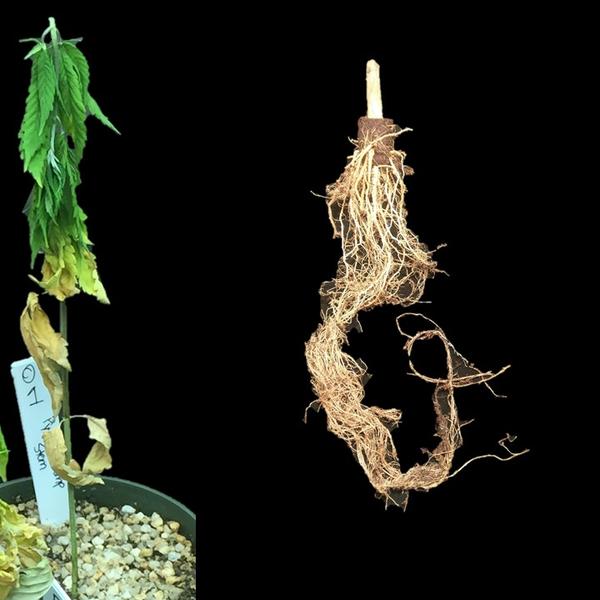Introduction
Pythium root rot is a common problem for North Carolina producers of all crops. Many Pythium species have a wide host range, which can limit management strategies, including crop rotation. This disease is particularly severe under cool, wet conditions and when plants are under environmental stresses that may increase susceptibility to disease.
Pathogens
This disease is caused by several species of Pythium, which can cause Pythium root rot and damping off of industrial hemp in both the field and greenhouse. Pythium spp. are water molds, oomycetes, and move through water films to find a host plant. Two species have been confirmed in industrial hemp, including Pythium aphanidermatum and P. ultimum; though other Pythium species may also cause disease in hemp.
Pythium spp. are ubiquitous in agricultural environments and can survive on wild hosts in agricultural fields and forested environments. These organisms can also survive and disperse in natural water sources like rivers, streams, or lakes.
Host Crops and Plants
Pythium species have a wide host range, and can cause root rot and pre- and post-emergence damping off in a variety of species. Many common host crops include cotton, soybean, corn, tobacco, cucurbits, other vegetable crops, and ornamentals. Several weed species may also host Pythium species.
Symptoms
Pythium species can be responsible for both pre- and post-emergence damping off. Pre-emergence damping off occurs when infection prior to seed germination. Infection shortly after germination can lead to weakening of the developing stem and eventual plant collapse. Later infections can lead to root and crown rot. Symptoms can include overall plant stunting, wilting, and leaf yellowing and drop. When plants are uprooted, lesions and necrosis can often be seen on the roots.
Disease Cycle
Pythium species are able to reproduce both sexually and asexually. Asexual structures called sporangia contain mobile spores, zoospores, that are mobile and travel through water to find an infect new hosts. Oospores are formed from the combining of hyphae from two mating types and are capable of causing infections to plants directly or serve as long-term resting structures. Pythium spp. can overwinter as oospores in pots, soil, or plant debris, and, upon the presence of conducive conditions, spores germinate to infect new host tissues and restart the disease cycle.
Favorable Environmental Conditions
Plants are more prone to infection by pathogens, including Pythium species, when already stressed by poor environmental conditions that favor disease. Hemp plants are sensitive to excessive water, which may make them more susceptible to diseases. As Pythium spp. can spread via water, overly wet conditions favor increased incidence of Pythium root rot. Other factors that can stress plants include soil compaction, cool conditions, and poor drainage. In the field, planting on beds can help improve drainage and alleviate some conditions that can promote root rot. In the greenhouse, proper sanitation and water quality control can help prevent the spread of disease. Avoid using irrigation from natural water sources like lakes, streams, rivers, or ponds.
Management
Prevention via proper sanitation and cultural practices is the best defense against infection by Pythium spp. Rapid seed germination and establishment can help reduce loss due to damping off by getting seedlings through the susceptible stage more quickly. Cool, wet conditions during germination can promote damping off, and planting should occur when conditions favor rapid growth and development. Raised beds and other techniques that decrease soil compaction and improve drainage may also help control Pythium spread.
Greenhouse sanitation for cuttings or seeding pots is also important for reducing root rot. Avoid reusing plastic trays. Expanded polystyrene trays should be steam sanitized between uses. All media should come from disease-free sources. Water used in the greenhouse should be from city-sanitized or well sources to reduce potential contamination of Pythium spp. spores. Avoid excess water where possible to limit stress and limit spread of Pythium spp. spores.
There are currently no effective, legal chemistries available for use in hemp to manage Pythium spp.
Useful Resources
The NC State University Plant Disease and Insect Clinic provides diagnostics and control recommendations.
The NC State Extension Plant Pathology Portal provides information on crop disease management.
The NC State Industrial Hemp Portal provides updates for industrial hemp management and production in North Carolina.
The North Carolina Agricultural Chemicals Manual provides pesticide information for common diseases of North Carolina. The manual recommendations do not replace those described on the pesticide label, and the label must be followed.
For assistance with a specific problem, contact your N.C. Cooperative Extension agent.
Acknowledgements
This factsheet was prepared by the NC State University Field Crops and Tobacco Pathology Lab in 2019.
- Check out our Facebook and our Twitter!
Publication date: Aug. 8, 2019
Recommendations for the use of agricultural chemicals are included in this publication as a convenience to the reader. The use of brand names and any mention or listing of commercial products or services in this publication does not imply endorsement by NC State University or N.C. A&T State University nor discrimination against similar products or services not mentioned. Individuals who use agricultural chemicals are responsible for ensuring that the intended use complies with current regulations and conforms to the product label. Be sure to obtain current information about usage regulations and examine a current product label before applying any chemical. For assistance, contact your local N.C. Cooperative Extension county center.
N.C. Cooperative Extension prohibits discrimination and harassment regardless of age, color, disability, family and marital status, gender identity, national origin, political beliefs, race, religion, sex (including pregnancy), sexual orientation and veteran status.

